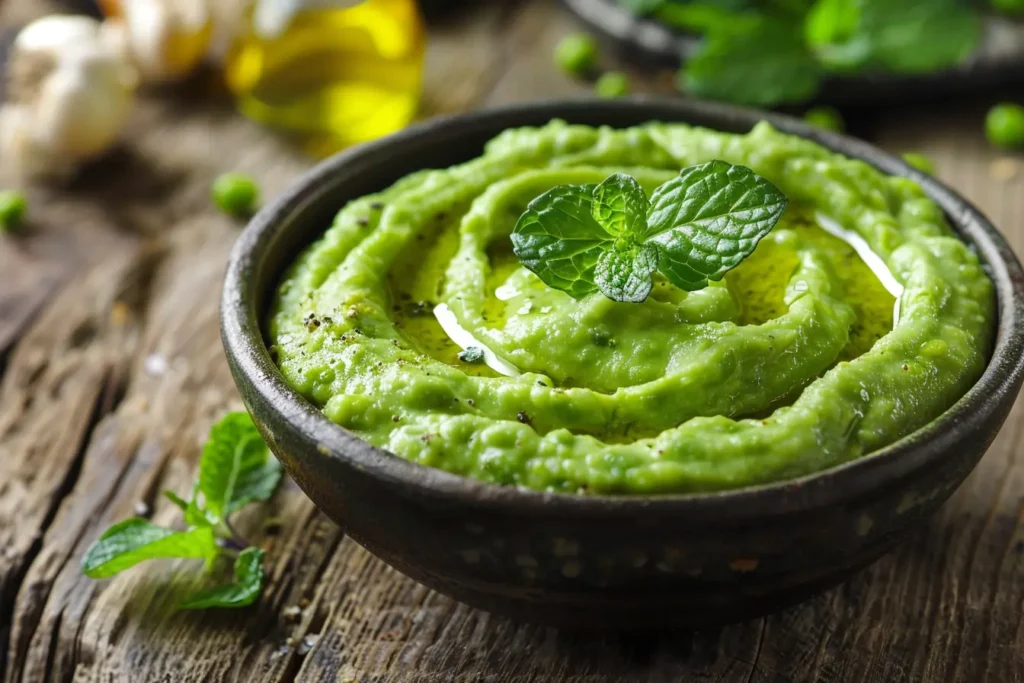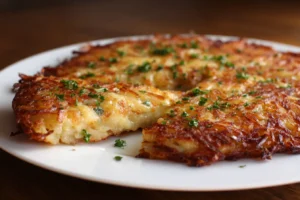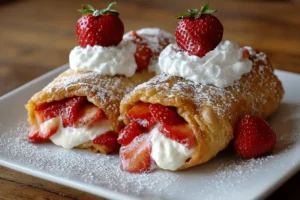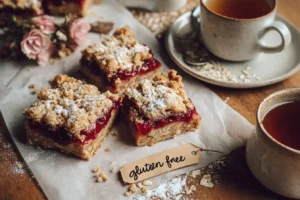Story Time: How a Bag of Peas Saved Dinner
It was one of those nights — no plan, no groceries, and a hungry kid side-eyeing me like I’d ruined his life. All I had was a forgotten bag of frozen peas.
In a moment of kitchen panic brilliance, I tossed them in a pot with garlic, a little butter, and mint. Blended it up. Smoothed it out. Pea purée.
And somehow… it looked fancy. Like restaurant fancy.
We ate it with toast, and my kid even asked for seconds (a win of Michelin-star proportions).
Since then? I’ve never looked at peas the same way.
Introduction: The Secret Star of Your Plate
Let’s be honest — when you think of a “wow” side dish, peas probably don’t top the list. But what if I told you they could be creamy, vibrant, elegant, and downright impressive? Enter: pea purée — the green goddess of the dinner plate.
Whether you’re serving it under garlic parmesan chicken meatloaf, spooning it next to a cozy crockpot steak and potatoes, or sneaking veggies into a toddler’s brunch with bisquick sausage muffins, this silky purée pulls triple duty as a side, sauce, and spread.
In this guide, I’ll show you how to make the perfect pea purée — plus pro tips, delicious variations, and chef-level tricks that anyone can pull off in their kitchen.
Let’s blend something beautiful.
Table of Contents
Table of Contents
What Is Pea Purée, Really?
At its core, pea purée is exactly what it sounds like — peas, blended until smooth. But don’t let the simplicity fool you. This vibrant green mash can be rustic or refined, depending on how you make it.
Unlike mushy peas (a classic British side made from dried marrowfat peas), pea purée uses fresh or frozen garden peas, blended with herbs, aromatics, and sometimes butter or stock. The result? A silky, sweet, slightly savory purée that tastes like spring and comfort had a baby.
According to Healthline, peas are loaded with fiber, vitamin C, and plant-based protein — so you’re not just getting pretty color on the plate, you’re getting real nutrition too.
You’ll find pea purée artfully smeared under scallops in fine dining restaurants (just check out Great British Chefs’ technique), or served as a nutritious base for toddler-friendly meals. It’s also a game-changing upgrade to the usual side of steamed veg.
In short? Pea purée is simple, versatile, and surprisingly luxurious.
Ingredients & Tools: Keep It Simple, Make It Silky
Print
Pea Purée
- Total Time: 10 minutes
- Yield: 1½ cups (3–4 servings as a side) 1x
- Diet: Vegetarian
Description
This creamy, vibrant pea purée is the perfect green goddess side dish — light, smooth, and packed with flavor. Whether you’re spooning it under scallops, spreading it on toast, or blending it into baby food, this quick recipe brings elegance and nutrition to any plate.
Ingredients
-
2 cups frozen green peas (or fresh)
-
1 tablespoon unsalted butter (or olive oil for dairy-free)
-
1 small garlic clove, minced (optional)
-
1 tablespoon fresh mint, chopped (or parsley/basil)
-
Salt and freshly ground black pepper, to taste
-
1 teaspoon lemon juice (optional but brightens flavor)
-
2–4 tablespoons reserved cooking water (as needed)
Instructions
-
Cook the peas:
Bring a pot of salted water to a boil. Add peas and cook for 3–5 minutes until tender and bright green. Drain, but reserve ¼ cup of the cooking water. -
Sauté aromatics (optional):
In a small pan, melt butter and sauté minced garlic until soft and fragrant — about 1 minute. Skip this if you want a simpler or baby-friendly version. -
Blend:
Add peas, garlic butter, herbs, and lemon juice to a blender or food processor. Add 2 tablespoons of cooking water and blend until smooth. Add more water gradually to reach desired texture. -
Season and serve:
Taste and adjust seasoning with salt and pepper. For extra-silky texture, press through a fine mesh sieve. Serve warm or chilled.
Notes
-
Make it vegan: Swap butter for olive oil or coconut oil.
-
For babies: Skip salt and garlic. Blend until ultra-smooth.
-
Storage: Store in an airtight container for up to 4 days in the fridge or 3 months in the freezer.
-
Texture tip: Always blend while the peas are still warm for the smoothest result.
- Prep Time: 5 minutes
- Cook Time: 5 minutes
- Category: Side Dish
- Method: Blended
- Cuisine: Modern European / Fusion
Nutrition
- Serving Size: ½ cup
- Calories: 90 kcal
- Sugar: 4.5 g
- Sodium: 120 mg (depending on seasoning)
- Fat: 3 g
- Saturated Fat: 1.2 g
- Unsaturated Fat: 1.8 g
- Trans Fat: 0 g
- Carbohydrates: 13 g
- Fiber: 4 g
- Protein: 5.5 g
- Cholesterol: 5 mg (0 if olive oil is used)
You don’t need a fancy pantry or chef’s toolkit to make pea purée — just a handful of fresh (or frozen) ingredients and a few kitchen basics.
Essential Ingredients
- Peas – Fresh or frozen green peas work beautifully. Frozen are quick and just as nutritious.
- Butter or olive oil – For that silky, rich texture.
- Salt & pepper – Season well, taste often.
- Garlic or shallots – Optional, but they add depth and warmth.
- Herbs – Mint is the classic pairing, but parsley, basil, or tarragon can be equally delicious.
- Lemon zest or juice – A squeeze of brightness brings it to life.
Tip: If you’re making a vegan version, swap the butter for olive oil or a splash of coconut milk for creaminess.
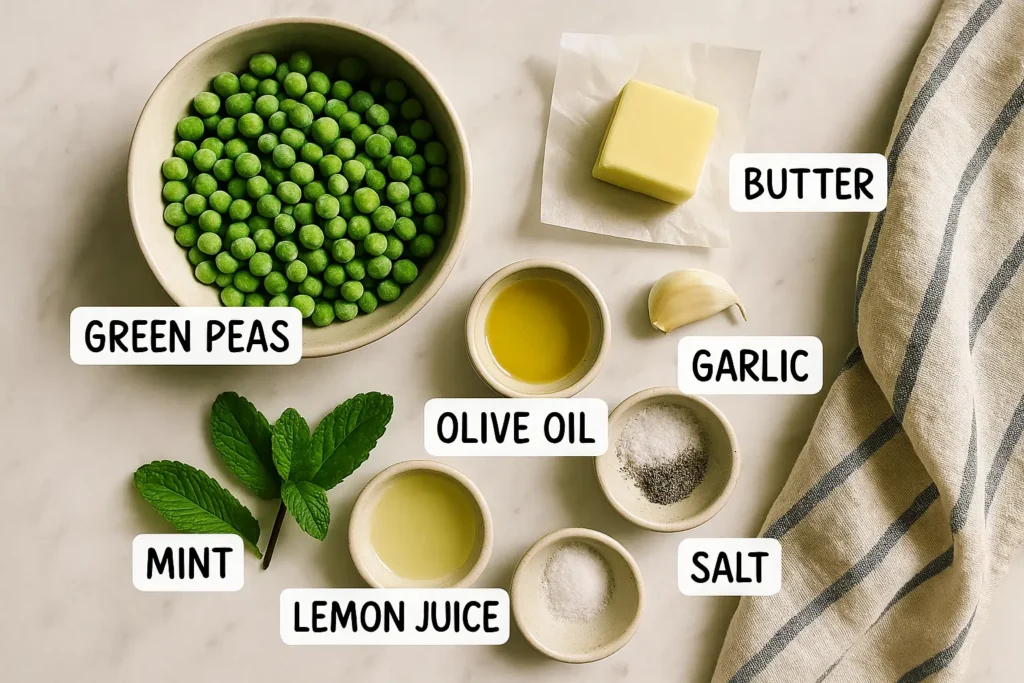
Tools That Make It Easier (But Aren’t Mandatory)
- Blender or food processor – For that smooth, whipped finish.
- Immersion blender – Super convenient for puréeing directly in the pot.
- Mesh strainer or sieve – Want that ultra-silky restaurant texture? This is your secret weapon.
- Rubber spatula – For pressing the purée through the sieve (and scraping every last bit).
No blender? No problem. You can totally mash it with a fork or potato masher for a more rustic version. Less smooth, more soulful.
Step-by-Step: How to Make the Perfect Pea Purée
This dish proves that the easiest recipes can still steal the show. With just a few steps, you can turn humble peas into a silky, flavorful purée that looks and tastes like it came out of a professional kitchen — minus the white coat.
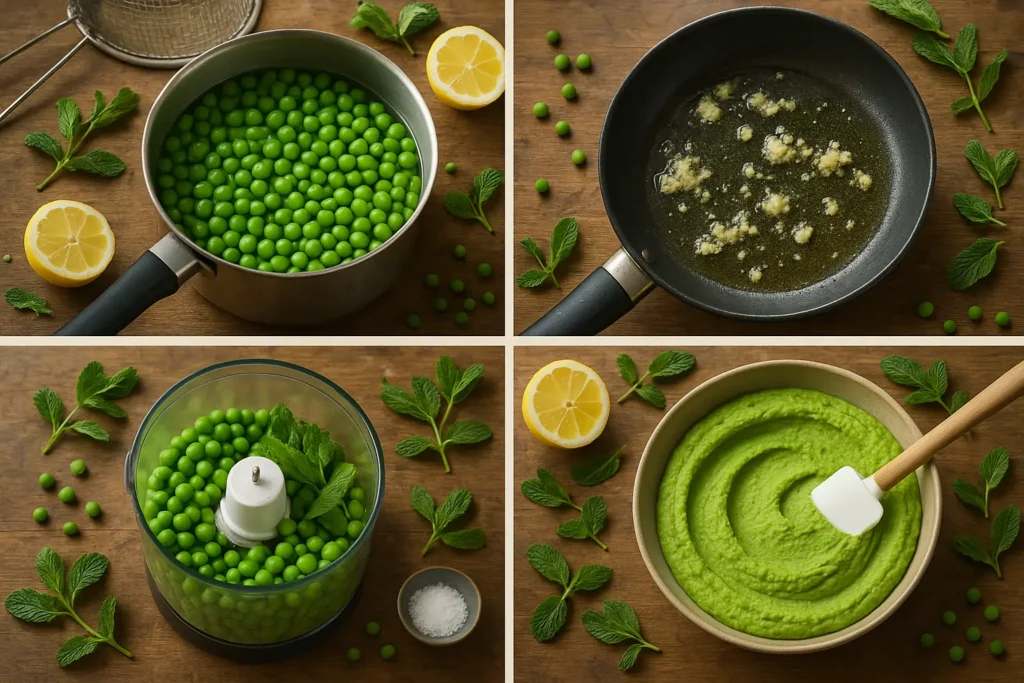
Boil or Steam Your Peas
Bring a pot of salted water to a boil, then add your peas (fresh or frozen — we’re not judging). Cook for about 3–5 minutes, just until tender and bright green. Don’t overdo it — overcooked peas = dull flavor and sad color.
Pro Tip: Save ¼ cup of the cooking water before draining. You’ll use this later to adjust the texture.
Add Flavor (This Is Where the Magic Happens)
In a small pan, sauté garlic or shallots in a bit of butter or olive oil until soft and fragrant. This step adds a rich, aromatic base to your purée. Want mint or lemon zest? Add it here — gently, so you don’t overpower the peas.
Blend It Smooth
Toss the peas and flavor boosters into a blender, food processor, or grab your immersion blender and get puréeing. Add a splash of your reserved cooking water and blitz until smooth.
You can go rustic with a chunky texture or keep blending for a whipped, cloud-like finish.
Optional — Strain for Restaurant-Quality Texture
Craving that ultra-smooth, spoon-hugging texture? Press it through a fine mesh sieve using a spatula. It strains out the skins and leaves you with a glossy, chef-level finish.
No time? No sieve? Totally fine. The flavor will still shine through.
Taste and Adjust
Now for the fun part — seasoning! Add salt, pepper, and a squeeze of lemon juice to brighten it all up. If it’s too thick, add a touch more cooking water or olive oil. If it’s too thin, just simmer gently for a few minutes to reduce.
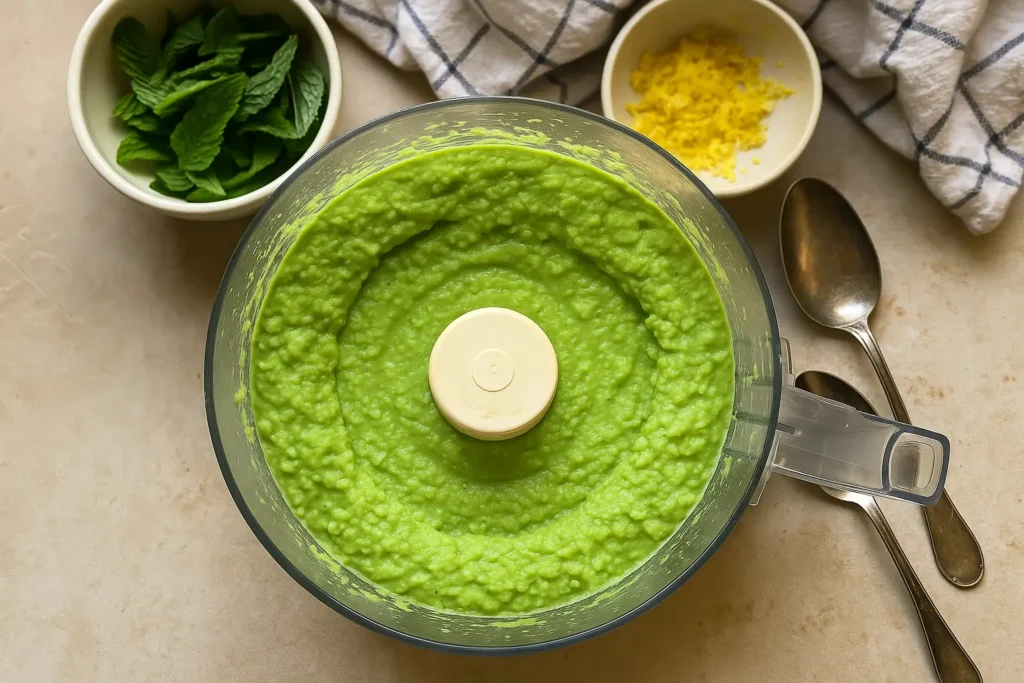
Flavor Mastery: Variations, Mistakes & Chef-Approved Tricks
Whether you’re cooking for picky kids, dinner guests, or just your hungry self, pea purée is wildly versatile. But like anything simple, it can go wonderfully right… or a little wrong. Here’s how to master it like a pro.
Flavor Variations to Suit Every Mood
Classic Mint & Butter
The go-to. Soft, sweet peas blended with butter and a handful of mint — a combo straight from the Great British Chefs’ playbook.
Zesty Lemon-Garlic
Bright, citrusy, and sharp. Add lemon zest, a squeeze of juice, and sautéed garlic for a flavor-packed purée that wakes up any plate.
Vegan & Dairy-Free
Swap butter for olive oil, coconut milk, or even tahini. For creaminess without dairy, Healthline recommends healthy plant-based fats like these.
Baby/Toddler-Friendly
Use no salt, a splash of olive oil, and blend until ultra-smooth. According to Solid Starts, peas are a fantastic early food rich in fiber, protein, and vitamin C.
Spiced-Up Twist
Add a pinch of cumin, chili flakes, or smoked paprika for a savory version that pairs beautifully with grilled meats or tofu.
Common Mistakes to Avoid
- Overcooking your peas: Turns them dull and mushy. Just 3–5 minutes is plenty.
- Under-seasoning: Don’t be shy with salt or acid. Peas love brightness — lemon, vinegar, or even a splash of pickle brine.
- Adding too much liquid: It’ll thin your purée into soup. Always add slowly and blend gradually.
- Skipping the straining step: Optional, yes. But if you want that restaurant-quality texture, it’s a game-changer. (See how chefs do it here).
Pro Tips to Elevate Your Pea Purée
- Reserve your cooking water. It’s starchy and full of flavor — perfect for thinning without watering down.
- Always blend while the peas are hot. It blends like a dream and locks in that bright, beautiful green.
- Add herbs at the end. Blending mint too early can dull the color and turn bitter.
- Swirl in a flavored oil. Think mint oil, lemon oil, or chili oil — for that fine dining touch.
Need help picking the right tool? The New York Times Wirecutter guide has tested the best immersion blenders — great for silky purées with less cleanup.
How to Serve Pea Purée
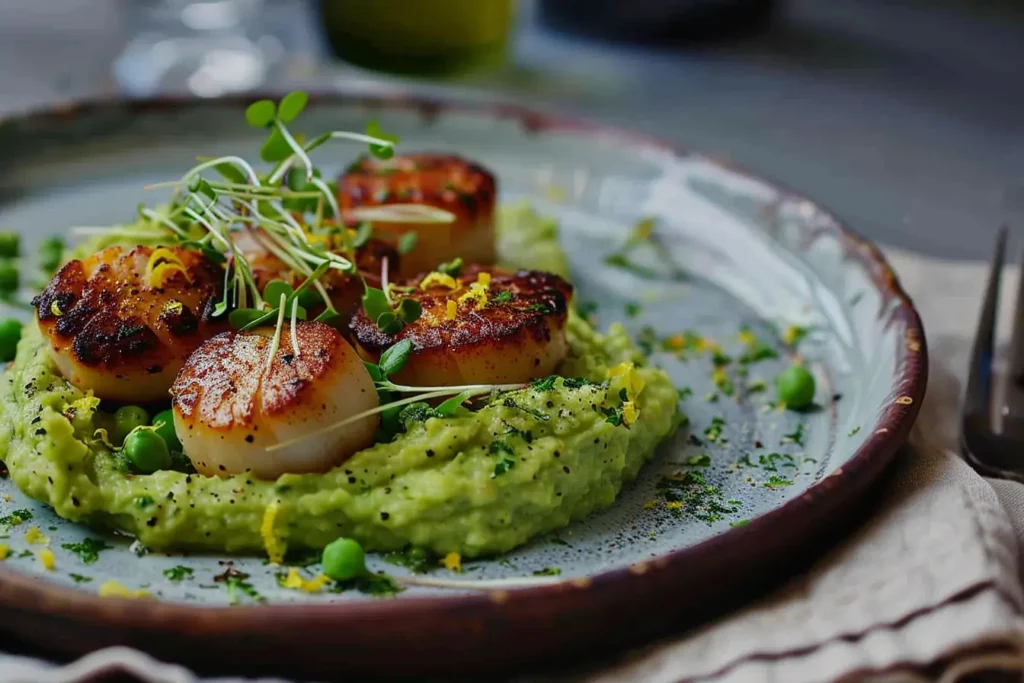
So you’ve blended your pea purée to perfection — now what?
This is where the fun begins. Pea purée isn’t just a side dish; it’s a green canvas for your most delicious ideas. Creamy, fresh, and subtly sweet, this little mash plays well with everything from meat to toast to baby meals.
Here’s how to serve pea purée like a pro (or just a really clever home cook):
As a Side for Meats & Seafood
- Swirl a spoonful of minted pea purée under garlic parmesan chicken meatloaf or grilled lamb chops for a bistro-worthy plate.
- Serve pea purée under seared scallops or crispy salmon for a vibrant, restaurant-style presentation.
- Spoon warm green purée sauce next to crockpot steak and potatoes — the contrast is chef-kiss perfect.
On Toast, Crostini, or Brunch Boards
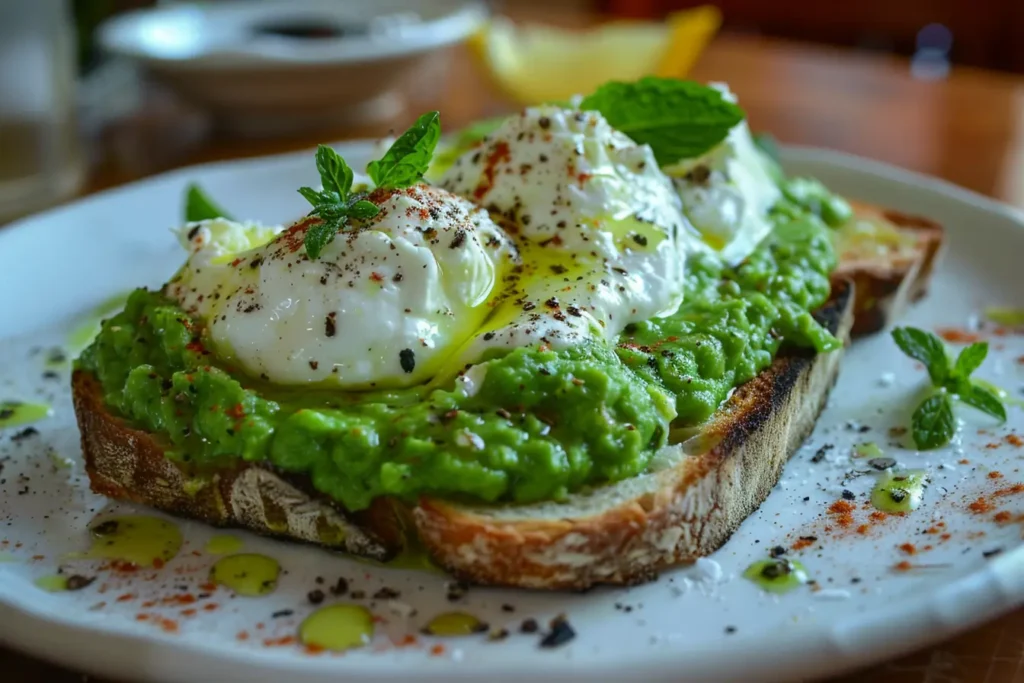
- Spread a thick layer of pea mash on sourdough and top with feta, burrata, or soft-boiled eggs.
- Add a few crushed red pepper flakes, lemon zest, or even bacon bits for savory crunch.
- Pair with bisquick sausage muffins and fruit for a cozy weekend brunch.
As a Base for Bowls & Veggie Plates
- Spoon warm pea purée into a shallow bowl and top with roasted carrots, crispy chickpeas, or grilled tofu.
- Finish with a swirl of herbed or chili oil for a pop of flavor and a touch of drama.
For Babies & Toddlers
- Serve ultra-smooth pureed peas warm, paired with mashed sweet potatoes or scrambled eggs.
- Want more texture? Mix with turnip green soup or soft rice.
Bonus Idea: Use It Cold
Yep, you can chill pea purée and use it like a dip or spread. Try it as a dip with pita chips, tucked into wraps with grilled chicken, or paired with crunchy veggie sticks — it never misses.
Pro Serving Tip: Pea purée looks amazing when plated with the back of a spoon or piped in little swirls. Simple trick, big impact.
Nutrition Breakdown: What’s in a Spoonful of Pea Purée?
Sure, pea purée is silky and elegant — but it’s also a quiet little powerhouse of nutrition. Whether you’re spooning it beside steak or feeding it to your toddler, you’re giving your body more than just a pretty green swirl.
Let’s peek inside each silky spoonful of pea purée — it’s more powerful than it looks:
Pea Purée (per ½ cup serving):
- Calories: ~90 kcal
- Protein: ~5–6g (hello, plant-based gainz 💪)
- Fiber: ~4g
- Fat: ~3g (varies by oil/butter choice)
- Carbs: ~12–15g
- Sugars: ~4–5g (naturally sweet — no sugar added!)
- Sodium: Depends on your seasoning
Sourced from the USDA FoodData Central — specifically cooked green peas without added fat or salt.
Why Peas Pack a Punch
- Fiber-rich – Helps regulate digestion and keeps you fuller, longer.
Peas are among the most fiber-dense green vegetables — great for gut health. - Plant-based protein – With nearly 6g per serving, Healthline calls peas “a legit protein source” for vegetarians and little ones alike.
- Loaded with antioxidants – Lutein, carotenoids, and polyphenols help support eye health, immunity, and inflammation control.
- Vitamins A, C, K – Essential for glowing skin, healthy blood, and immune function.
- Iron & magnesium – Especially beneficial for toddlers, menstruating women, and plant-based diets.
And the best part? When you turn them into pea purée, you preserve nearly all that goodness — no cream, no fillers, just straight-up green gold.
Want even more? According to Cleveland Clinic, green peas support blood sugar control, heart health, and weight management.
Frequently Asked Questions (FAQ’s)
How do you make pea purée?
Making pea purée is super simple: boil or steam peas (fresh or frozen) for 3–5 minutes, then blend with butter or olive oil, salt, pepper, and optional herbs like mint. You can strain it for a silky finish or leave it rustic. Serve warm or chilled depending on the dish!
Is pea purée healthy?
Yes! Pea purée is packed with fiber, plant-based protein, and vitamins like A, C, and K. It’s low in fat, naturally sweet, and can be made dairy-free or baby-friendly. It’s one of the easiest ways to sneak veggies into any meal — without sacrificing flavor or texture.
Is pea purée the same as mushy peas?
Not quite. While both use peas, mushy peas are typically made from dried marrowfat peas soaked and slow-cooked until thick and chunky — a British comfort food classic. Pea purée, on the other hand, is made with fresh or frozen green peas and blended smooth, often with herbs and butter, for a fresher, silkier result.
Do you serve pea purée hot or cold?
Both! Pea purée is usually served warm with meats, fish, or sides, but it can also be served cold as a dip, spread, or summer starter. For example, cold pea purée with burrata or on toast is absolutely divine. Just make sure it’s seasoned well and blended smooth either way.
Why do the British eat mushy peas?
Mushy peas are a beloved part of traditional British cuisine, often served with fish and chips. They’re hearty, inexpensive, and deeply nostalgic. Unlike pea purée, they’re not about elegance — they’re about comfort and filling your belly with something warm and familiar.
Conclusion: Green, Gorgeous, and Seriously Underrated
Who knew a bag of peas could turn into something so… sophisticated?
Whether you’re plating it under scallops, spooning it onto toast, or blending it into baby food cubes, pea purée is one of those secret weapon recipes — easy, flexible, and endlessly impressive.
It’s buttery without being heavy, healthy without being boring, and honestly? Kind of a show-off in the best way.
Need inspiration for what to pair with your silky green swirl? Try it with garlic parmesan chicken meatloaf for a comfort-food twist, or level up brunch with burrata cheese toast and a soft-poached egg.
Cooking for kids? Pair it with bisquick sausage muffins or spread a little on the side of their cottage cheese banana bread — veggie win!
for more recipes, follow me in Facebook, Pinterest and medium—Happy cooking!
